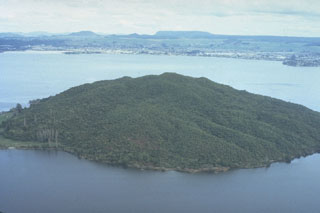Report on Rotorua (New Zealand) — August 2000
Bulletin of the Global Volcanism Network, vol. 25, no. 8 (August 2000)
Managing Editor: Richard Wunderman.
Rotorua (New Zealand) Small-scale hydrothermal eruption on 18 September
Please cite this report as:
Global Volcanism Program, 2000. Report on Rotorua (New Zealand) (Wunderman, R., ed.). Bulletin of the Global Volcanism Network, 25:8. Smithsonian Institution. https://doi.org/10.5479/si.GVP.BGVN200008-241816
Rotorua
New Zealand
38.08°S, 176.27°E; summit elev. 757 m
All times are local (unless otherwise noted)
On 18 September 2000, a new feature was formed at a private property along Tarewa Road as a result of a small-scale weak hydrothermal eruption. About 0530 on 18 September, spring 653 erupted, producing waves and surges, but eyewitnesses did not report any significant eruption column. Surge marks were especially well developed to the N within a newly constructed bund, an earthen structure designed to capture the fluids from eruptions. At 0545, eruptive activity began at a new site ~15-18 m S of spring 653. The eruption may have been triggered by the removal of a clothesline mast and subsurface anchoring concrete block three days earlier. Residents reported that heating was occurring in the same area several weeks before the outbreak. Vigorous activity was estimated to have lasted about 5-10 minutes before activity started to decline. Small-scale hydrothermal eruptions have been reported in the past from nearby sites.
Geological Summary. The 22-km-wide Rotorua caldera is the NW-most caldera of the Taupo volcanic zone. It is the only single-event caldera in the Taupo Volcanic Zone and was formed about 220,000 years ago following eruption of the more than 340 km3 rhyolitic Mamaku Ignimbrite. Although caldera collapse occurred in a single event, the process was complex and involved multiple collapse blocks. The major city of Rotorua lies at the south end of the lake that fills much of the caldera. Post-collapse eruptive activity, which ceased during the Pleistocene, was restricted to lava dome extrusion without major explosive activity. The youngest activity consisted of the eruption of three lava domes less than 25,000 years ago. The major thermal areas of Takeke, Tikitere, Lake Rotokawa, and Rotorua-Whakarewarewa are located within the caldera or outside its rim, and the city of Rotorua lies within and adjacent to active geothermal fields.
Information Contacts: Brad Scott, Wairakei Research Center, Institute of Geological and Nuclear Sciences (IGNS), Private Bag 2000, Wairakei, New Zealand (URL: http://www.gns.cri.nz/).

